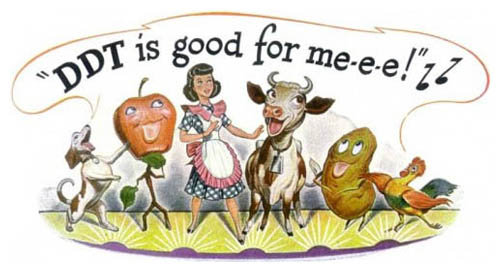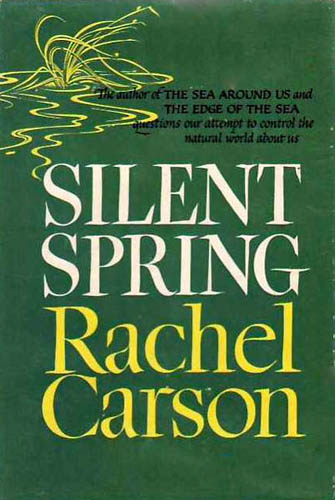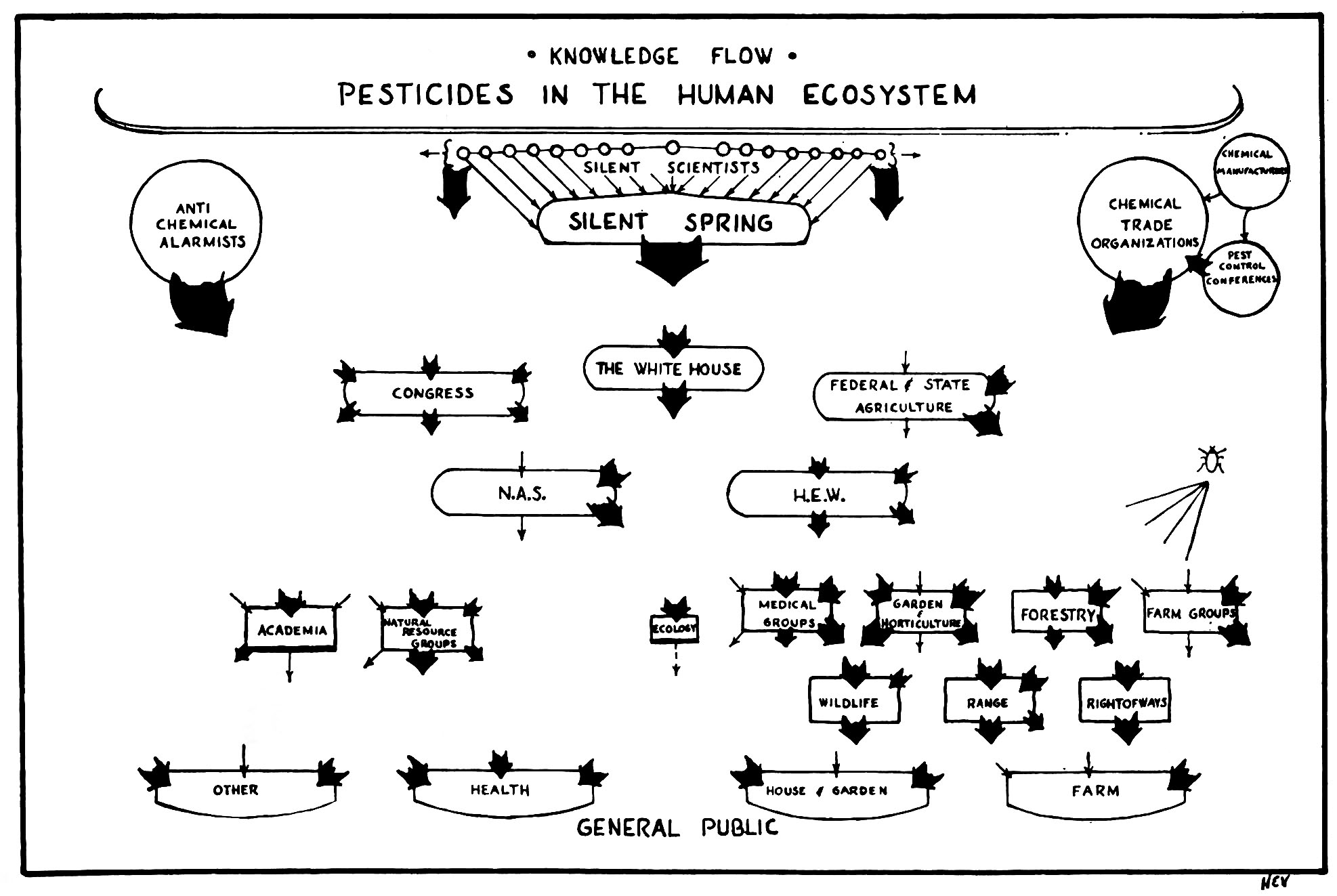From the Archives: Scientists' Conversations About Rachel Carson and DDT, 1944 to Today
By Katie L. Burke
It’s doubtful we would have Earth Day without Rachel Carson. Her pioneering 1962 book Silent Spring sparked the environmental movement and infused ecological ideas into mainstream thinking. So to recognize this date, I combed through the archives of American Scientist to get a sense of how scientists have discussed Carson and Silent Spring over time.
April 22, 2015
From The Staff Agriculture Biology Chemistry Communications
It’s doubtful we would have Earth Day without Rachel Carson. Her pioneering 1962 book Silent Spring sparked the environmental movement and infused ecological ideas into mainstream thinking. So to recognize this date, I combed through the archives of American Scientist to get a sense of how scientists have discussed Carson and Silent Spring over time. It’s fascinating to see what rhetoric changes, stays the same, or continues to resurface periodically. I’ve compiled these clips into a timeline, to which I’ve added significant dates from the environmental movement for reference.
1944: First mention of DDT in American Scientist.
1946: "The [contemporary] entomologist has found new methods of protecting our crops and livestock against the ravages of insects, and his now famous DDT bids fair to protect not only our crops, an important part of our subsistence, but to go far toward the control of diseases which have plagued the human race throughout the centuries."–F. L. Duley, "Progress in Soil Science," November 1946.

1946: "DDT has been a godsend…."–Louis F. Fieser, “Scientific Mission to Palestine,” October 1946.
1948: Paul Müller awarded Nobel Prize in Physiology or Medicine for research on DDT as malarial control.
1951: Kirtley F. Mather reviews Rachel Carson’s 1951 book The Sea Around Us in American Scientist, saying, “It will inspire new respect for scientific habits of mind and awaken dormant interest in scientific pursuits.” Carson won the National Book Award for this work of nonfiction.
1962, June: First excerpt of Rachel Carson’s book Silent Spring published in The New Yorker.

1962, September: Silent Spring published. American Scientist did not review it.
1963: American Scientist publishes an article titled “People and Pesticides” by Thomas H. Jukes, which oddly never mentions Carson or Silent Spring overtly. Jukes does refer to the work in a rather oblique way:
The image of a fragile and exquisite songbird dying in paralytic convulsions from the callous and unjustified application of a repulsive and deadly chemical sprayed broadcast over a defenseless landscape—this picture, regardless of the question of its possible authenticity, has a powerful effect on sensitive individuals. Many conservationists have expressed deep concern, since they view this image as part of a long train of events in which technology and weight of numbers have led man in North America to prevail with dire results in the struggle against Nature.
He goes on to present evidence that DDT does not harm robins and other birds.
1964, March: American Scientist publishes “Pesticides—in our Ecosystem” by Frank E. Egler, exhibiting ideas clearly influenced by Carson. Egler vividly describes Silent Spring’s immediate cultural influence:
The years 1962 and 1963 were so completely dominated by one person and one book that historians of the future may well refer to this period as the Carsonian Era of "Silent Spring." With initial appearance of excerpts of the book in the June New Yorker magazine, the world has been treated to the most absorbing and instructive body of scientific and pseudoscientific literature it has ever known. There has been defense and counter-defense, a focusing upon minutiae, distortion, innuendo, bias, claims of emotionalism themselves written with extreme and apparent emotion. The book rose to the Best Seller lists, and stayed there for months. With it all, I seriously wonder how many of the most vocal have really read the book! I have made it a point to ask everyone who expresses a strong opinion about it to me, whether he has really read the book. The replies unfortunately were never taped by modern recorders. In all truthfulness, I here report that I have yet to find the pro-pesticide man who admits to reading the book. (Maybe this statement will elicit affirmative replies—but, after all, a year and a half has passed.) The case is typified by the Director of Research of a large chemical manufacturer who, when asked about the book, stammered apologetically that he really had not read it; he tried; several times; but he just could not bring himself to read it. It is abundantly clear from some of the anti-reviews, that the reviewers themselves really had not read it through. They read into it what they feared to find, what the anti-chemical alarmists said they had found. In short, they criticized it for what they thought was in it…

Another milestone was reached on May 15, 1963, with the Report of the President’s Science Advisory Committee, published by the White House. This Report did not alter the pesticide picture as Rachel Carson had portrayed it. It vindicated that picture, and lent a stature to it that one person alone, even Dr. Carson, could not have given.
The story of pesticides in 1962–1963 is that of the angry, emotional, and sales-conscious reaction of the industry and of its disciples in government agriculture, abetted albeit innocently by the obsessively scientific, not that of the cool and calm progress of scientific knowledge through a democratic society.
1964, April: Rachel Carson dies of breast cancer.
1967: American Scientist publishes the article “Biology and the Public Good,” by George Gaylord Simpson, which reinforces Carson’s influence as felt by contemporary scientists:
The many readers of Rachel Carson’s Silent Spring are familiar with another set of intensely serious problems in applied biology. The widespread use of chemicals to control noxious insects has had a whole chain, or many chains, or side effects on other animals and on man, ranging from merely undesirable to downright disastrous. Thus the attempt to solve one problem of applied biology has caused numerous new problems…. Bringing poison into the environment and attacking certain members of the community does not affect just those members. It changes the whole ecological setup and has repurcussions, usually undesirable, through the whole community and out beyond a particular community. The problem should have been studied, and now it must be studied, in the broadest way and up to the very highest level of the hierarchy of biological organization.
1968: Egler (mentioned above) reviews the book Pesticides & Pollution, by K. Mellanby. He notes that Mellanby refers to Carson’s Silent Spring as “an advocate’s view,” and then points out that she is actually a scientist who includes important research not considered by Mellanby.
1970, April 22: First Earth Day, established by Senator Gaylord Nelson of Wisconsin was a “national teach-in on the environment.”
1970: National Environmental Policy Act (83 Stat. 852) establishes Council on Environmental Quality and requires evaluation of potential environmental impacts of pending federal legislation and agency programs.
1970, December: US Environmental Protection Agency established.
1971: American Scientist publishes an article by S. Dillon Ripley, “Conservation Comes of Age,” that reviews 30 years of biology, putting Carson’s contribution into the context of larger conversations happening in the 1950s. He notes that during the 1960s, biologists realized:
Ecology had suddenly become an urgent area for research, as urgent as biomedical research. What Paul Weiss and René Dubos had been saying all along was true. This did not mean that most biologists took alarm at what Rachel Carson was writing about. In 1962 thinking people were divided about Carson. The chemical companies produced cogent arguments to refute her thesis. Besides, [Paul] Müller had been given the Nobel Prize in 1948 for his research on DDT. Pesticides could save lives either by eliminating certain vector-borne diseases or by increasing food supplies for the ever-burgeoning human population.” He ends the piece with a summary of where the environmental movement stood at that moment: “Humankind is going to have to adjust to a set of ecological principles concerning living space, food availability, predation, and all the evolutionary adaptations involved in a true concept of our total available niche space. This is what the new conservation is all about.
1972: Agricultural use of DDT banned in the United States.
1973, December: Endangered Species Act passed.
1976, July 4: US Fish & Wildlife Service declares bald eagle as a national endangered species. (Many states had listed it as endangered during the 1960s, and a federal law preceding the Endangered Species Act also already declared it endangered in most of the United States.)
1977: Clean Water Act passed (based on the Federal Water Pollution Control Act of 1948, which had been heavily amended in 1972).
1980, March–April: In a review of I. R. Hill and S. J. L. Wright’s book Pesticide Microbiology, R. Bartha recognizes Carson’s influence and her controversial status in American Scientist:
Eighteen years have passed since Rachel Carson published her Silent Spring. Though alarmist and one-sided, her book undoubtedly created a useful awareness of the real and potential dangers of pesticide use. Scientific research, spurred by public concern and regulatory demands, has since produced an impressive body of information on the fate and effects of pesticides in the environment.
In another review in the same issue, Samuel H. Greenblatt notes that Carson is strangely missing from Peter Wild’s 1980 book Pioneer Conservationists of Western America.
1980, June: Rachel Carson awarded Presidential Medal of Freedom
1980, November–December: In another 1980 book review in American Scientist—one by Granville H. Sewell, of Herman Koren’s Handbook of Environmental Health and Safety—Carson is far from overlooked:
The Handbook reflects the mood of environmental health today. By the 1950s, when the Sanitary Revolution had successfully educated the public on the need for microbial cleanliness in water and food, environmental health studies usually meant mundane training of restaurant inspectors or operators for water treatment plants. This changed during the heady years following the appearance of Rachel Carson’s Silent Spring, as the public awoke to the impact of advanced industrial technology on the natural environment. Significantly, resulting governmental programs were centered in new agencies, such as the U.S. Environmental Protection Agency, and not in the moribund department of health which could not respond to the broader frame of reference. But neither could human health considerations be omitted. Now environmental health is benefiting from the movement back to basics—in this case, protection of human health and conservation of resources.
1992: United Nations Earth Summit in Rio de Janeiro.
1995: Senator Gaylord Nelson is awarded the Presidential Medal of Freedom for founding Earth Day.
1996: In the first mention of Carson in American Scientist since 1980, in a review of the book Environmental Values in American Culture by Willett Kempton, James S. Boster, and Jennifer A. Hartley, Robert Cameron Mitchell, talks about how much most Americans are on board with the worldview put forward in Silent Spring:
The authors find a remarkable "cultural consensus" on the ecological ideas first popularly expressed in the 1960s by Rachel Carson in Silent Spring, and they believe this explains why Americans readily accept the idea of global warming.
Almost 10 years later, this statement is rather startling in light of today’s polarization about climate change among the general public.
1997: A book review refers to environmental writers’ struggles to write another book with the kind of widespread appeal of Silent Spring. In her review of Climate Change and the Global Harvest: Potential Impacts of the Greenhouse Effect on Agriculture, Mary Peet laments, “Unfortunately, the Silent Spring that would raise public consciousness about climate change has yet to be written.”
1998: In an American Scientist book review, Carson is once again contextualized in history:
We’ve learned from Watergate. We’ve learned from Rachel Carson. We know how important rhetoric is in molding our perception of the world. We also know how central the environment is to our very survival.
1998–1999: Rachel Carson’s Silent Spring is given her place in history by American Scientist authors first in a 1998 review of a book on the greatest feuds in scientific history and in Philip and Phylis Morrison’s 1999 list of the books that shaped the 20th century.
2001: DDT banned worldwide for all uses except for malaria control at the Stockholm Convention.
2004: Bestselling science fiction novelist Michael Crichton declares, “Banning DDT killed more people than Hitler,” reigniting debate over ban on DDT.
2006: The World Health Organization declares its support for the indoor use of DDT in African countries to combat malaria.
2007: Competitive Enterprise Institute launches RachelWasWrong.org website, highly critical of Carson and Silent Spring.
2007, August: US Fish and Wildlife Service removed the bald eagle from the federal list of endangered species.
2007, September–October: David Schoonmaker reviews a book of essays and a biography about Carson in “A Witness for Nature,” which tells more about Carson’s life, background, and path to her environmental crusade.
2008: An American Scientist review talks about ideas established by Barry Commoner well before Silent Spring’s publication that had made their way into mainstream environmental thinking and also probably influenced Carson. The reviewer Sylvia Tesh’s opinion about how Earth Day has changed is especially apropos:
[Today] Earth Day is an occasion for corporations to boast about how green they are, the major environmental organizations are politically cautious, and the most popular environmental gurus preach only individual responsibility.
2012: In a review of William Souder’s biography of Carson, Julianne Lutz Warren writes:
The scientific evidence in Silent Spring held up under intense scrutiny. Carson was right, Souder reminds us, and even some early, outspoken skeptics conceded that she was. It’s also worth remembering that Carson did not call for a complete end to chemical uses, as some detractors accused her of doing, but for use with precaution. Another common criticism was one-sidedness. Recounting a point-counterpoint–style report aired on CBS in 1963, Souder shows how Carson could present her work as providing the missing piece on pesticide threats in a mosaic of opinions that otherwise overemphasized the chemicals’ safety and benefits for agriculture and disease control without accounting for costs such as evolving pest resistance and harms to health via biomagnification. Carson, who was suffering from the effects of radiation treatment for breast cancer, countered the arguments of government officials and industry spokespeople with calm and precision, winning the debate. Although many people admitted that she got the facts right, they nonetheless did not always embrace her overarching narrative. The battle her story ignited was not so much over the integrity of scientific knowledge as the worldviews that shaped responses to it.
Souder claims that environmentalism, with its core concern for health, need not have become a partisan issue, but that it did so because it began with Silent Spring and the fierce attacks it sparked. If this supposition is true, Sounder inspires the conclusion that it is because Carson’s outlook meant that health was a matter encompassing the totality of the world of life, thus requiring collective care, if not loving reverence, for Earth. This perspective threatened the predominant acceptance of violent control of nature as a means of speedily increasing economic wealth, and thus it evoked strong, if not always clearly reasoned, conflict. Carson was calling for a profound transformation of attitudes—one that would require not only fewer poisons but also a humbler worldview. "I truly believe," she wrote, "that we in this generation must come to terms with nature, and I think we’re challenged as mankind has never been challenged before to prove our maturity and our mastery not of nature, but of ourselves."
In the year between Silent Spring’s publication, now just over 50 years ago, and her death from cancer in 1964, Carson deepened her investigation into global climate change, a longtime interest of hers. A newly released report by the Conservation Foundation warned that heavy fossil fuel burning, which released the greenhouse gas carbon dioxide into Earth’s atmosphere, was likely to be accompanied by higher global temperatures, melting ice, rising sea levels and changes in distributions of marine species. We know now, based on strong scientific evidence, that these predictions and more are coming to pass. Like the still-rampant, careless dispersal of other pollutants, excessive greenhouse gas emissions by humans is a collective problem for Earth’s health today—which all the more urgently requires the daring exercise of just, collective care.
2015: Recently, I reviewed a book about the vaccination debate, Eula Biss’s On Immunity: An Inoculation, that includes a chapter reflecting on Silent Spring. Although the discussion of Carson’s book didn’t make it into the review, I found this passage by Biss especially thought-provoking:
Silent Spring begins with a ‘Fable for Tomorrow’ in which Carson imagines an idyllic landscape of oaks, ferns, and wildflowers that is rapidly transformed into an apocalyptic wasteland where birds no longer sing. In the pages that follow, workers who have been picking oranges fall violently ill, a housewife who hates spiders develops leukemia, and a boy who runs to greet his father, just back from spraying the potato fields, dies that night from pesticide poisoning. It is a horror story in which man’s creation, his monster, turns against him. Like Dracula, this monsters moves through the air as mist and lies dormant in the soil. And like the plot of Dracula, the drama of Silent Spring depends on emblematic opposition—good and evil, human and inhuman, natural and unnatural, ancient and modern. The monster in Dracula has ancient origins, but in Silent Spring evil takes the form of modern life.
Thanks to environmental historian Jamie Lewis of the Forest History Society for his feedback on several of the events included on this timeline.
Correction: This post originally said that Senator Gaylord Nelson was from California. He was from Wisconsin.
American Scientist Comments and Discussion
To discuss our articles or comment on them, please share them and tag American Scientist on social media platforms. Here are links to our profiles on Twitter, Facebook, and LinkedIn.
If we re-share your post, we will moderate comments/discussion following our comments policy.